By Junno Arocho Esteves
VATICAN CITY (CNS)/JACKSON – Catherine Cook, superintendent for Catholic Schools for the Diocese of Jackson joined 2,000 educators and education advocates in Rome in November for a conference marking the 50th anniversary of the Second Vatican Council’s Declaration on Christian Education and the 25th anniversary of “Ex Corde Ecclesiae,” St. John Paul II’s apostolic constitution on Catholic universities.
The trip was full of highlights for Cook, including Mass at the Tomb of St. Peter, two days in Castel Gandolfo hearing presentations from educators around the world and a question and answer session with Pope Francis.
Taking questions from administrators and faculty members, the pope spoke about Catholic identity in education and warned about the dangers of exclusion and educating within “the walls” of a selective and safe culture.
Roberto Zappala, headmaster of Milan’s Gonzaga Institute, asked the pope what makes a school “truly Christian.” Christian education, the pope responded, is not just about providing catechesis, but requires educating children and young people “in human values,” particularly the value of transcendence.
Spanish Lasallian Christian Brother Juan Antonio Ojeda, a professor at the University of Malaga, asked the pope how educators can foster a culture of encounter and restore the broken bonds among schools, families and society.
The pope said Catholic educators must overcome a tendency of being selective and must work to restore the broken “educational alliance” among families, schools and society, which tends to place profit over people.
“This is a shameful global reality,” the pope said. “It is a reality that leads us toward a human selectivity that, instead of bringing people together, it distances them; it distances the rich from the poor; it distances one culture from another.”
The pope urged the group to find new and innovative ways to make Catholic education accessible to every family who wants it.
When asked how Catholic schools could contribute to building peace in the world, the pope called on them to educate the poor and the marginalized even if that meant cutting the staff at some of their schools in wealthier neighborhoods.
Cook said she appreciated hearing from international educators. “I learned that the concerns we have about Catholic education in the U.S. aren’t that different than everyone else and yet there are significant differences,” said Cook. “We all want to think of our schools as safe havens, but in some parts of the world, where school may provide the only meal a child gets in a day or provide a truly safe place to be – that challenge is significantly different,” said Cook.
She said that Mass at the Tomb of St. Peter was a very moving experience and she used it to pray for those who work in Catholic schools here.
Pope Francis also gave the participants a homework assignment: to think about how to fulfill the corporal and spiritual works of mercy through education.
“Think about it in this Year of Mercy: is mercy just about giving alms or how can I do the works of mercy in education?” he said.
Schools in the diocese have adopted TEAM or teaching everyone about mercy as a theme for this year and each school is trying to embrace the Jubilee year in its own way.
(Maureen Smith contributed local content to this story)
Category Archives: Diocesan News
Three pastors announce retirements
By Maureen Smith
JACKSON – Three pastors have announced their retirement from active ministry, Msgr. Michael Flannery, Fathers Frank Cosgrove and Charles Bucciantini.
Father Cosgrove, 75, admits he has mixed feelings about leaving his post in Meridian. He was diagnosed with Parkinson’s disease five years ago, but has been managing his illness up to now. “My energy level has been lower,” said Father Cosgrove. “I hoped I would know when it is time – and it is,” he added.
Father Cosgrove remembers reading missionary magazines when he was a child in Ireland. When then Father Jeremiah Hardnett came to his high school recruiting priests for Mississippi, Father Cosgrove knew he wanted to go. “I’m sincerely glad I did. It’s been a happy 50 years,” he said.
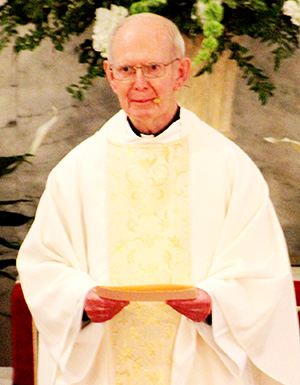
Father Francis Cosgrove, pictured at his Jubilee Mass in Merdian is retiring to St. Catherine’s Village in Madison. (Mississippi Catholic file photos)
Father Cosgrove served in Natchez, at the Cathedral of St. Peter and St. Therese in Jackson, Oxford, Madison and Meridian. During his time in Jackson he served as director of Youth Ministry and later as vicar general under Bishop William Houck.
Father Cosgrove remembers his time in youth ministry as being full of adventures. During his first youth convention he was nervous about managing the 700 young people in the old Heidelberg Hotel. With so many students, he was sure he had filled the hotel. When he saw a young couple go into a room and close the door he sprang into action. “I banged on the door and told them, ‘you know the rule at this convention is that if you are in the room of a person of the opposite sex, you will leave the door open.’ The young man got very red faced and said, ‘but sir, we are on our honeymoon!’” He spoke of his love for helping young people find their vocations.
“One of my values over the years has been trying to build lay leadership, especially among young people,” said Father Cosgrove. He hopes to remain active in ministry, just not as a pastor. He will move to St. Catherine’s Village in Madison in February and asks for people to pray for him.
Msgr. Flannery knew he wanted to be a priest at the age of six. “Initially I was going to become a Franciscan and stay in Ireland, but this priest came from Mississippi and talked about the needs there,” he said. The challenge appealed to him. He liked the idea of participating in a variety of ministries, from working at a school to instructing people in
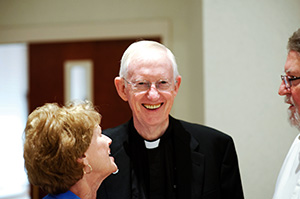
Msgr. Michael Flannery, who is retiring in 2016, celebrated his 50th anniversary of priesthood in June, 2014.
RCIA and celebrating multiple Masses every weekend. “I have enjoyed my priesthood, I have to say and I would encourage any young boy to consider it,” he said. Msgr. Flannery served in Jackson, Pascagoula, Rosedale, Cleveland, Clarksdale and Madison. He worked in the tribunal for 20 years of his ministry and served at the mission in Saltillo, Mexico, which he describes as his most memorable assignment.
“When I passed in over the border, I knew two phrases, buenos dias, and un poco. That was my total vocabulary. I got there at four o’clock in the afternoon and said ‘buenos dias,’ which is good morning. And the guy said to me in Spanish, ‘do you speak Spanish?’ and I said ‘un poco.’ I’d shot my whole wad,” he said, laughing. Msgr. Flannery added that learning the language was not the real challenge. Learning the culture was the real work. He described a people with true inner joy despite the poverty and isolation they faced.
“I went there believing I would make a contribution to the mission. The reality was they are the ones who enriched my life by their faith,” explained Msgr. Flannery. “It deepened my understanding of priesthood and what ministry was all about,” he added.
Many of the people in Saltillo had not seen a priest in a decade as he started to make the rounds of the mountain villages so there was plenty of work to do.
He remembered a time when Bishop Brunini came to celebrate confirmation in one of the villages. “Five hundred people turned out for the confirmation. We were expecting 100. So when we began conferring confirmation, there was a stampede because they thought we had run out of Sacred Chrism. About four of us had to make a circle around Bishop Brunini and we’d let two people in at a time to be confirmed,” he said.
He plans to live in Madison and help in the diocesan tribunal as the new guidelines for annulments streamline that process.
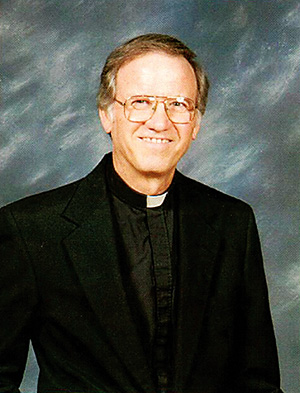
Father Charles Bucciantini, retiring pastor of Leland St. James, has a list of projects he would like to complete.
Father Bucciantini, 69, has a long list of projects for his retirement. He wants to learn piano, teach in a literacy program, visit all the national parks and more. “I am looking forward to it,” said the current pastor of Leland St. James.
The Natchez native has served in Biloxi, Clarksdale, Starkville, Cleveland and Leland.
He said his favorite part of being a pastor is being a counselor. “It’s one of the gifts the Lord has given me and I enjoy it,” he said.
Father Bucciantini said when he is working with someone trying to discern their vocation he tells them to follow their joy. “I think people are going to be most happy if they are doing what the Lord wants them to do. If the Lord has prepared them for it, that’s what they will be happiest to do. I would urge them to discern it with someone they can trust,” he said. Father Bucciantini hopes to live in Ridgeland when he’s not traveling.
Diocese of Jackson Jubilee of Mercy
Monday, Jan. 25, 2016
Feast of the Conversion of St. Paul
– Special Pilgrimage day for Vicksburg Site
Tuesday, Feb. 2, 2016
Feast of the Presentation of the Lord and the Day for Consecrated Life
– Jubilee for Consecrated Life and the closing of the Year for Consecrated Life.
Prayers for vocations to consecrated life.
Monday, Feb. 22, 2016
Feast of the Chair of St. Peter
– Pilgrimage to Holy Door Opportunity
– Day of Works of Mercy by parish and diocesan staff
Friday and Saturday, March 4-5,
2016
“24 Hours for the Lord”
Pilgrimage days
– Confession in all parishes OR area reconciliation services in pilgrimage city sites
– Works of Mercy by parishes and parish organizations
Sunday, April 24, 2016
Jubilee for boys and girls
(ages 13 – 16)
Pilgrimage Day
Tuesday-Sunday, July 26 – July 31, 2016
World Youth Day in Krakow, Poland.
– July 28 – 179th anniversary of the establishment of the diocese – Pilgrimage Day
Sunday, Sept. 4, 2016
– Jubilee for workers and volunteers of mercy
– Pilgrimage Day and Day of Works of Mercy
Thursday, Sept. 15, 2016
Our Mother of Sorrows
Original Patroness of the Diocese
Stabat Mater recited in all parishes, families and homes throughout diocese.
– Special Pilgrimage opportunity for Natchez pilgrimage site
Sunday, Nov. 6, 2016
– Jubilee for prisoners.
Pilgrimage Day – Prayer for Prisoners and Works of Mercy
Sunday, Nov.13, 2016
Closing of the Holy Doors in the dioceses of the world.
– Holy Door closed in St. Peter Cathedral
– Final Pilgrimage Day – Prayer for Peace
(A list of pilgrimage sites is available on www.jacksondiocese.org)
Office of Child Protection introduces new ongoing training
By Maureen Smith
JACKSON – Effective, Jan. 1, the Diocese of Jackson will complement its safe environment program with monthly online training programs from VIRTUS.
It is both the foundation and the structure of all the risk control initiatives undertaken by National Catholic Services. Every employee and volunteer in the diocese will get an email every month with a link to training material. He or she will have to answer a multiple-choice question after reading the bulletin.
The VIRTUS Online Program is integrated with the Diocese of Jackson Protection of Children eApps Database. The eApps database will track and report who has participated in the monthly web-based safe environment training bulletins. Additionally, the VIRTUS website will include Diocesan Protection of Children polices and resource information.
All those who minister to children, young people and vulnerable populations will be provided a user ID and password to enter www.virtus.org, and will receive a system email reminder within the first full week of each month that a training bulletin is available to view online.
Anyone logging into the VIRTUS website is offered the Spanish option as well.
New employees and volunteer are still required to participate in a live “Called to Protect” initial training. The month subsequent to the initial training, an applicant will start receiving the monthly bulletin emails.
VIRTUS is the brand name that identifies best practices programs designed to help prevent wrongdoing and promote “rightdoing” within religious organizations. The VIRTUS programs empower organizations and people to better control risk and improve the lives of all those who interact with the Church.
The National Catholic Risk Retention Group, Inc. (National Catholic) created the programs. Msgr. Kevin McCoy, past board chairman of National Catholic, asked whether child sexual abuse could be prevented and, if so, how? In March of 1998, National Catholic invited prominent national experts in many disciplines to discuss these questions at a forum in Washington, D.C. From those discussions, the initiative for the VIRTUS programs was created. The National Catholic Board of Directors selected an Ad Hoc Committee to oversee development of the programs. The Ad Hoc Committee was assisted by a steering committee of nationally known experts and program and service providers.
“The VIRTUS® Programs empower organizations and people to better control risk and improve the lives of all. The training programs are comprehensive and multi-dimensional incorporating proven best practice standards for the ‘prevention’ of child sexual abuse,” wrote Pat O’Neal, Virtus executive director in an email. “The programs also incorporate best practice procedures for identifying problematic situations, reporting child sexual abuse, screening and selection of employees and volunteers, and addressing victim/survivor advocacy and healing,” O’Neal added.
“Most initial training programs establish awareness, but few change behavior. With the VIRTUS programs, the potential for successful behavioral change can be increased via the VIRTUS Online system. Monthly scheduled online training bulletins reinforce knowledge gained during awareness training with a continued focus on the prevention of child sexual abuse and the abuse of vulnerable adults,” said O’Neal.
Virtus is Latin for excellence, valor, moral strength and courage — the same characteristics needed for caring adults who interact with children and protect them from abuse. Through these programs that have reached more than 2.5 million adults, caring adults become partners with parents to ensure that all children are protected.
Vickie Carrollo, Safe Environment Coordinator for the diocese said she is excited about the new program. “I am always happy when we can strengthen our program, but I also believe the monthly bulletins are interesting and cover such a huge variety of topics,” she said.
Carrollo wanted to express her thanks to everyone involved in safe environment training and maintenance. “Thank you for the hours you have given, for your service to the Church and for the children you have protected. Many blessings as we continue our journey into the future of safe environments.”
St. Dominic’s Performs Rare, Lifesaving Valve in Valve Heart Surgery
On Thursday, Nov. 19, St. Dominic’s cardiologists and cardiovascular surgeons performed a rare surgical procedure by placing a prosthetic heart valve inside of an existing valve that had been replaced surgically 15 years ago.
This transcatheter aortic valve replacement (TAVR) allows physicians to guide a heart valve from a small needle stick in the groin into the heart replacing the malfunctioning heart valve. While this procedure carries a certain amount of risk, as do all procedures, it will now allow the 70-year-old patient to have a normal life expectancy.
“At St. Dominic’s we are excited to be leading the way in bringing all of this exciting new technology to Mississippi and we are committed to continuing to provide access to these cutting edge techniques to our community,” said Antoine Keller, M.D., FACS, cardiothoracic surgeon at St. Dominic Hospital.
“When this patient received treatment 15 years ago, heart valves were replaced through much more invasive, open procedures,” Keller said. “Now with this lifesaving technology, we are able to perform heart valve replacement using only catheters and wires, dramatically reducing the amount of discomfort patients feel and the length of time it takes to recover.”
Gray Bennett, M.D., cardiologist at St. Dominic Hospital, said TAVR has been a breakthrough in care for patients that are at the highest risk for death surrounding a valve replacement. “We are offering them an alternative to the traditional surgery, which has worked in the past for the lower risk patient,” he said. “But by using a team approach with cardiothoracic surgeons and interventional cardiologists, we can even offer TAVR to patients who have had a previous valve replacement and lower their risk.
“We are lucky to have the team, the talent and the technical skill that it takes to offer patients much more advanced treatment,” said William Crowder, M.D., cardiologist at St. Dominic Hospital. “TAVR enables us to provide lifesaving treatment to high risk patients who otherwise could not be treated.”
Lay Ecclesial Ministers gather for reflection, formation
By Maureen Smith
LOUISVILLE – Lay Ecclesial Ministers (LEM) from across the Diocese of Jackson met Wednesday and Thursday, Dec. 2-3, with Bishop Joseph Kopacz, Father Kevin Slattery, Vicar General; Father Mike O’Brien, Vicar for Clergy and Fran Lavelle, director of Faith Formation.
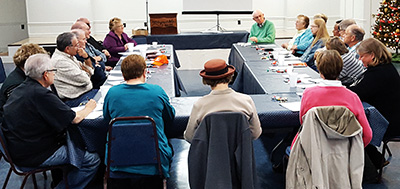
Lay Ministers from across the diocese met to discuss their ministry and future formation opportunities Dec. 2-3.
The informal meeting, held at Lake Tia O’Kahta, was the first of many planned gatherings for the group. There are currently 13 LEMs in the diocese who care of the pastoral needs in parishes where there may not be a full-time priest. In 2005, the U.S. Conference of Catholic Bishops (USCCB) wrote a document called ‘Co-Workers in the Vineyard,’ as a resource for bishops and those in pastoral ministry.
Bishop Kopacz went through some key points of the documents with those gathered and asked them to share their stories of how they got into ministry. Next year, the diocese will offer them a formation program called ‘Tending the Talents.’
The LEMs appreciated the gathering and learning more about one another. “As a whole, we all got into this ministry because we felt a call to become a lay minister,” said Deborah Holmes, Lay Ecclesial Minister for Bruce St. Luke the Evangelist. She said that up until now, she did not know the stories behind her fellow LEMs’ vocations. She also said she is very excited about the opportunity to gather with them again for formation. “The opportunity for growth for us is very important,” she said. Sometimes, a pastor or an LEM can feel isolated, so the chance to exchange ideas and learn together is welcome. “It makes us feel like we are unified,” said Holmes.
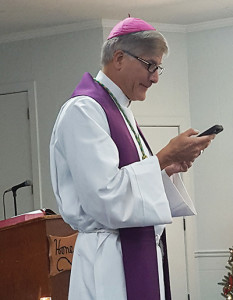
Bishop Kopacz uses his smartphone to read a letter from St. Francis Xavier at the closing Mass for the Lay Ecclesial Ministers. (Photo by Cathy Edwards)
James Tomek, LEM for Rosedale Sacred Heart agrees. “Just being alone and working, I don’t know what everyone else is doing and I don’t know if I am in tune with what else is going on,” he said. He said he sees his role as keeping his community together. He encourages lay participation on all levels in his parish.
Tomek, a retired professor for Delta State, said he is glad the bishop plans to make the gathering a regular one. “It’s vital. We’ve got emails and all that stuff, but every now and again, real presence is what’s needed,” he said.
At the closing Mass for the event, Bishop Kopacz noted that it was the feast of St. Francis Xavier, one of history’s most successful evangelizers. He read from a letter the saint wrote in India about how hungry people were to learn about the Christian faith, its prayers, rituals, scripture. Saint Francis said he could hardly rest or eat thanks to all the work he had before him. Bishop Kopacz thanked the LEMs for all of their work and dedication to the people of God in Mississippi.
Sister Teresa Shields retiring after three decades in Delta
By Maureen Smith
JONEST0WN – How can you save a town in the Mississippi Delta steeped in poverty, facing problems with drugs, lack of education and a lack of access to resources? “One child at a time,” said Sister Teresa Shields, a Sister of the Holy Names of Jesus and Mary, outgoing director of the Jonestown Family Center for Education and Wellness.
Sister Teresa has done her part in that effort, but her time in the Magnolia state is coming to an end. She is looking back on 30 years in the Mississippi Delta as she prepares to retire back to her home state of Washington and her board searches for her replacement. She said she has been talking to her board of directors about retiring for a while, but had to set a date to make the plan a reality.
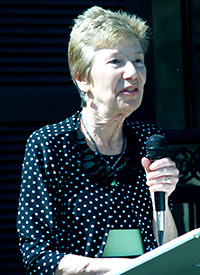
Shields
She came in 1984 to teach in Clarksdale at Immaculate Conception. When that school closed, she taught in Mound Bayou for a few years. When St. Gabriel School closed, “I still didn’t want to leave so I asked if I could stay and tutor. The (religious) community agreed if I could raise my own salary. So I wrote a grant to Our Sunday Visitor and got $10,000. I thought, that’s easy, to get money. So I did a little needs assessment and started an after school program,” said Sister Teresa.
A preschool followed along with programs to help educate and empower mothers. Helping teenagers transition into womanhood and manhood were the next programs added. Sister Kay Burton continues to work with teens and mothers in the community. Sister Deanna Randall, BVM, who had Montessori training came and helped the preschool embrace that program. In 1994, Sister Teresa led the charge to raise money to build a building for the Montessori program.
Tina Crawford works in the toddler program and drives a bus for the center. “This place means a lot. When I first came, most of the talk in town was about the sisters. They brought so much to the community,” said Crawford. She said the Montessori school offers children a chance to get ahead of their peers. “They are learning on a third and fourth grade level. They are doing actual math in there and actual science,” she explained. “The work is hands-on and the kids can work at their own pace,” she added.
Parent and teacher Lakisha Egans put two of her children through the school. “This program is very valuable,” Egans said. “It opens up another whole door for kids. They need that in a small town. Education is a big issue here in the Delta,” she said. Egans credits some of the success with parent involvement. “The parents are more involved because of how close this community is,” said Egans, adding that the compassion Sister Teresa and her community offer draw people to the center.
Young children are not the only ones served by the center. In 2005, the Jonestown Family Center got a grant for health and wellness and added a fitness center, located in a former nightclub. Director Lady Jackson welcomes all comers with a smile and plenty of encouragement.
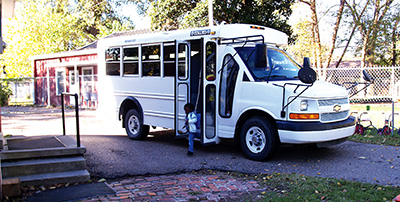
A grant helped secure a bus the Jonestown Center can use to pick up the children who attend the Montessori and preschool programs. (Photos by Maureen Smith)
Jackson said Sr. Teresa had a good reason to branch into fitness. “She had the vision of fitness center so we can educate not only the mind of the child, but the wellness of the body – getting people to eat right and exercise and take care of their bodies,” said Jackson. The fitness director inspires people with her own story of her journey to good health. “I found out my cholesterol was up and I’m not good at taking medication. That day I came home and I moved my furniture out of the way and I started working out,” said Jackson. She will support anyone who wants to turn their lives around.
She does not use one set program, instead letting people pick the type of exercise they want to try and encouraging them to try several before they settle on what works. “I don’t push what I do on other people, I let it be your choice. You want to walk. I let you walk. You want to ride the bike, you ride the bike. I just want you to do something.” Jackson said she knows of children in her church who suffer from diabetes and obesity and wants to offer an alternative. “Your body is a temple of God. You keep it healthy – you work on keeping it holy,” she said.
Not all of Jackson’s work is related to exercise. She also offers teenagers and young people a safe place to gather.

Grants and donations provided equipment for the Fitness Center, one of the newer programs in Jonestown.
“I love it. Sometimes people come here – they don’t come to work out, they have a lot of stuff on their mind. They want to talk,” she explained. “A lot of young men come down here to workout and stay out of trouble. The teenagers come and I help them. We talk about their goals, their future in life- where they want to be – what plans have they set in place to get to where they are going,” said Jackson. She encourages the young people to set both long and short term goals and then works with them on achieving the smaller milestones on the way to their ultimate dreams.
During the summers, she runs a program for kids that includes trips to nearby towns and team sports activities. Jackson said one of Sister Teresa’s gifts is being able to find just the right person for each ministry of the Jonestown center. Jackson started in the preschool program, and tried to retire, but Sr. Teresa kept bringing her back until she found the perfect fit in the fitness center.
Both Eagans and Crawford said Sister Teresa’s compassion sets her apart. Crawford said she is always willing to talk to anyone who needs her. Both hope compassion will be a hallmark of the new director for the center.
In 2012 a man from Jonestown broke into Sister Teresa’s home and stabbed and robbed her. “When I was hurt, everyone said they thought that was the end of the community center, but I did come back. I told the board, now is not the time, but maybe in a few years,” explained Sister Teresa. When she returned home after recovering from the attack she hosted a healing ritual in her home, sealing the four corners with oil and hanging up the hundreds of cards and letters she had received while she was away. She knew she wanted to continue the work of the Jonestown center, but also knew it was time to start urging the board to think about succession planning.
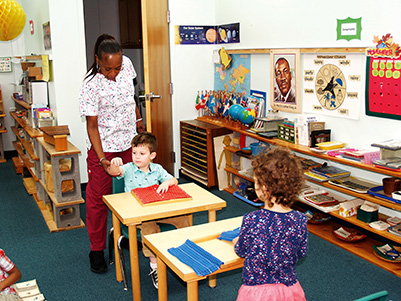
Maxine Kinnard, Montessori teacher, helps Josiah L. get settled while Edith R. watches. Some of the children in the program are second generation attendees.
Sister Teresa said she would like to see the Jonestown Family Center offer even more to the community. “We need a clinic. We need a bank. We need social services. We need a counselor, we need addiction counseling, so there are many needs,” said Sister Teresa.
Many of the children in the Montessori and Mothers as teachers programs now are the second generation to attend. Sister Teresa leaves knowing that the legacy of education and service has already made a positive impact on this community. “I think there are a lot more people that see another way of life is possible.”
The board hopes to have a new director in place in April or May. The Jonestown Family Center relies on donations to maintain its programs. To learn more about how to help, visit online at www.jonestownfamilycenter.com.
Oxford Parish offers Latin Mass
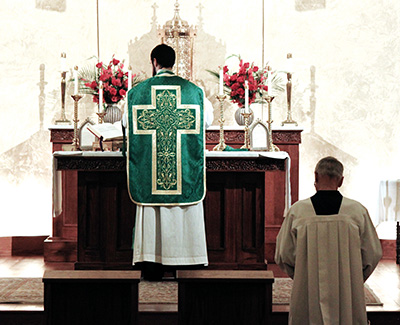
One of the most visual differences in Mass in the Extraordinary Form is that the priest celebrates with his back to the people. (Photo by Gene Buglewicz)
By Gene Buglewicz
OXFORD – Father Scott Thomas celebrated Mass in the Extraordinary Form at St. John the Evangelist Catholic Church in Oxford in November. The Mass wasn’t “extraordinary” as we usually define it, but the Mass was the Extraordinary Form, commonly known as the Latin Mass.
The Latin Mass as many Catholics know it came from Pope Pius V, who mandated a single form of the Mass at the Council of Trent (1545 – 1563). The Second Vatican Council (1962 – 1965) instituted a new, simplified liturgy that also substituted Latin for common language as well as restored a few elements which had been lost over time. In 2007, Pope Benedict XVI announced that the Extraordinary Form of the Mass could be practiced by individual parishes without permission, in part to better connect Catholics to the historical traditions of the church.
What are the differences a modern Catholic would see in the Mass in the Extraordinary form? As a bell rings, the priest enters the sacristy from the side of the altar and stands with his back to the congregation. The priest prays the Mass in Latin with English spoken only during the homily when the priest faces the congregation and addresses them.
Communion is taken at a communion rail which separates the altar from the congregation or at a kneeling bench in front of the priest. Rather than receiving the sacred Host in the hand, which is common today, the Host is taken directly on the tongue.
Worshiping at the Extraordinary Form of the Mass was offered as a special event for the University of Mississippi Catholic Campus Ministry students at St. John the Evangelist. Approximately 40 students made up the 125 parishioners and visitors who attended the Latin Mass.
Father Thomas, pastor of Clarksdale St. Elizabeth Parish, travels throughout the Diocese of Jackson celebrating the Extraordinary Form of the Mass for parishes who request it.
Mississippi Hispanics honor Our Lady of Guadalupe
By Elsa Baughman
JACKSON – The first celebration of the feast of Our Lady of Guadalupe in the Diocese of Jackson was held on Dec. 16, 1979, in the Cathedral of St. Peter the Apostle. Every year many of the parishes and missions hold in her honor mañanitas, a sunrise service on Dec. 11, Masses, processions and skits about her apparition. In some communities the faithful pray a novena of rosaries at different homes or in the church leading up to the feast day.
Saturday, Dec. 12, marks the 484th anniversary of her apparition to the Indian San Juan Diego in Tepeyac, Mexico.
In 1754 Pope Benedict XIV declared for Dec. 12 a special Mass and Office proper to the celebration on her feast day. In 1945, Pope Pius XII designated Our Lady of Guadalupe the Empress of the Americas noting that she had been painted “by brushes that were not of this world.” The following year he declared her to be the Patroness of the Americas. In 1988 the liturgical celebration on Dec. 12 was raised to the status of a feast in all dioceses in the United States.
For Mexicans living in the Jackson diocese the celebration has special meaning.
Herminia Martínez, a member of Hazlehurst St. Martin of Tours Mission, says that the feast of Our Lady of Guadalupe is a very special day in her native country, Mexico. “On Dec. 11 people decorate the front door of their houses with lights of different colors and with images of the Virgin of Guadalupe,” she said. Around 11 p.m. people gather in churches to sing songs and to pray the rosary, a tradition known as mañanitas.
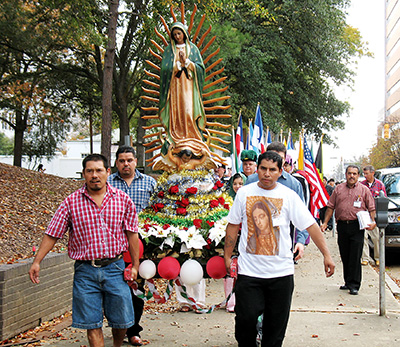
Members of the Cathedral of St. Peter the Apostle process with the statue of the Virgin of Guadalupe around the Smith Park every year praying the rosary before the 2 p.m. Mass.
Martínez remembers fondly the year she participated in the “Guadalupan torch run” when she was a teenager, walking and running with a group of friends from her home in San José Chiapas Puebla to the Basilica of the Virgin of Guadalupe in Mexico City, a journey that took all day and night. There, youth groups from different parts of the country lit their torches and then brought them, burning, to their local churches.
“You feel something special when you are running with that torch in your hands,” she said. “It’s a great joy to participate in this relay race.”
Martínez added that she has also participated in that event here in the United States when the “Guadalupan Torch Relay Race” has passed through Hazlehurst on its way to New York. “We received the lighted torch, we remember the tradition and we think about the message the runners bring.”
The International Guadalupan Torch Relay Race is sponsored each year by the Tepeyac Association of New York. The race begins in October at Our Lady of Guadalupe Basilica in Mexico City, progresses through several states in the United States and ends on Dec. 12 at St. Patrick’s Cathedral in New York City.
For the feast this year, Martínez is preparing the children of the parish to present a Guadalupan dance on Friday, Dec. 11, during the 6:30 p.m. Mass in honor of the Virgin of Guadalupe. “We will bring her flowers, we will sing and dance in her honor,” she said.
For Martínez, Dec. 11-12 are also special days of remembrance in a different way. Eleven years ago her father was dying on Dec. 11 but it seemed like something was holding him in this world. On that day, she prayed to the Virgin of Guadalupe that if her father was afraid of dying, to help him go in peace. “And he died that same day,” she said.
Growing up in the small town of Allende, in the state of Coahuila, Mexico, Blanca Cantu would pray the rosary to the virgin with her parents and siblings at different homes. “We prayed 46 rosaries, one daily for each star in the Virgin’s blue mantle, ending on Dec. 12 before the Mass on her feast day,” Cantu said.
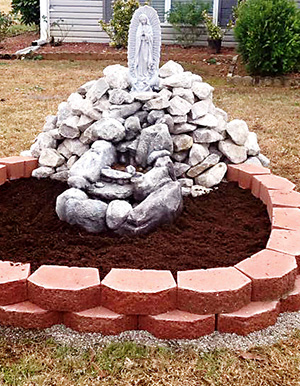
BELMONT – On Thanksgiving Day, Sandra Hernández with the help of her family, erected an altar for the Virgin of Guadalupe in the front lawn of her house. She posted this photo in Facebook with the cutline, “My little Virgin of Guadalupe is ready to be celebrated on her feast day.”
On Dec. 12, she added, the people would gather at 5 a.m. at the entrance of the town to walk for two hours toward their church, praying the rosary led by their pastor and singing songs. The Mass was celebrated at 7 a.m. followed by dances and a meal. “This is one of my most cherished childhood memories,” Cantu said.
As a member of Batesville St. Mary, Cantu is one of the organizers of the celebration in her parish, a tradition that began in 2009. She said that before the 7 a.m. Mass the congregation participates in a short procession from the parish center to the church. The adults and the children, many dressed as St. Juan Diego and others wearing Mexican dresses, bring flowers to the Virgin at the beginning of the celebration. This year the Mass will be on Saturday, Dec. 12.
This past Thanksgiving Day, Sandra Hernández and her family prepared an altar for the Virgin in the front lawn of their home in Belmont.
Her devotion for the Virgin of Guadalupe comes from her father who used to pray daily for her intersession. Hernandez’s father had a small statue of the Virgin and a crucifix on his night stand. “I was very young but I remember him praying everyday, in the morning or at night, calling the Virgin ‘My Lupita,’” she said. Lupita is a nickname for Guadalupe. Hernández said her father named the last of his seven daughters, Guadalupe.
“My mother taught me to pray the rosary, she has a big devotion for Mary. But my father passed on his faith and love for the Virgin of Guadalupe to me,” she explained.
She remembers that in her native town of Cuitlahuac, Veracruz, the community assembled close to midnight on Dec. 11 to pray the rosary and sing mañanitas. “I went with my family to this celebration which was always very well attended and afterwards we shared a meal,” she said. On the 12th we gathered again for Mass.
Gerardo Hernández of Jackson grew up in a small town in the state of Juanajuato in Mexico. During the months of November and December he took part in the “Hermandadez (Brotherhood) activities in Rincón de Alonso, his town, for the feast of Our Lady of Guadalupe.
“We processed from one town to another taking a statue of the Virgin on a pedestal to the small chapel in each community,” he said. Sometimes the group walked for two hours or more praying the rosary and singing songs written for the Virgin. The statue stayed in each town for several days and then it was taken to the next town until Dec. 12 when it arrived at the main church in the district.
As a member of the Cathedral of St. Peter the Apostle’s Hispanic ministry, Hernandez participates in the procession around Smith Park while praying the rosary and singing songs led by a group carrying a statue of the Virgin. This year the celebration is set for Sunday, Dec. 13, beginning at 1 p.m. with the procession. Bishop Joseph Kopacz will be the main celebrant.
Pastoral Assignments
Father Albeenreddy Vati is appointed Parish Administrator of Madison St. Francis Parish.
Father Matthew Simmons is appointed pastor of Meridian St. Patrick and St. Joseph Parishes.
Father Arokia Stanislaus Savio is appointed pastor of Grenada St. Peter Parish and Sacramental Minister of Charleston St. John Parish.
Father Alphonse Arulanandu is appointed pastor of Leland St. James Parish and the missions of Anguilla Our Mother of Mercy and Hollandale Immaculate Conception.
Father Joe Tonos is appointed Canonical Pastor of Bruce St. Luke Parish, but will remain pastor of Oxford St. John Parish.
Father Tim Murphy is appointed Sacramental Minister of Bruce St. Luke Parish.
Father Henry Shelton is appointed pastor of Brookhaven St. Francis Parish.
Father Juan Chavajay is appointed pastor of Yazoo City St. Mary Parish and Belzoni All Saints Parish.
Father Brian Kaskie is appointed Seminarian Director, while remaining pastor of McComb St. Alphonsus Parish.
Father Brian Kaskie is appointed Seminarian Director, while remaining pastor of McComb St. Alphonsus Parish.
Father José de Jesús Sánchez is appointed Promoter of Vocations, while remaining associate pastor of Meridian St. Patrick and Meridian St. Joseph.
We welcome two new priests from India, Father Panneer Sevam Arckiam and Father Xavier Jesutaj. They have not yet been assigned to parishes.
All appointments
are effective Feb. 1
+Joseph Kopacz.
Bishop of Jackson
